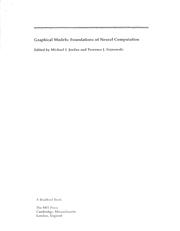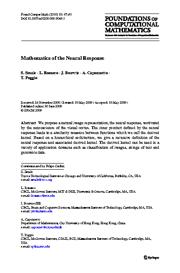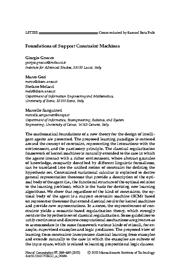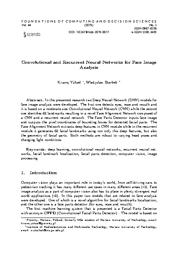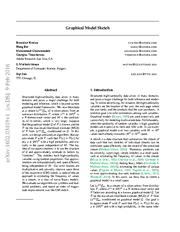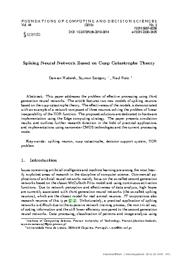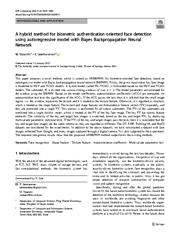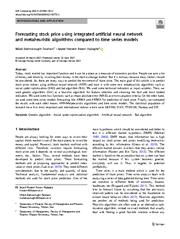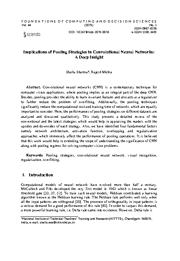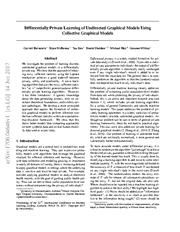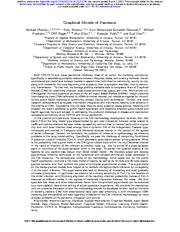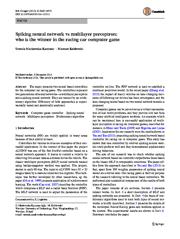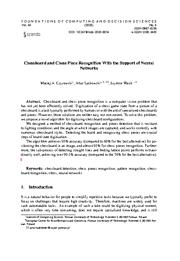A copy of this work was available on the public web and has been preserved in the Wayback Machine. The capture dates from 2019; you can also visit the original URL.
The file type is application/pdf.
Filters
Graphical Models: Foundations of Neural Computation
2002
Pattern Analysis and Applications
The selationship between these components underlies the computational machincq~ associated with graphical models. ...
A graphical model has both a str~lctural con~ponent-encoded L7p the pattern oI edges in the gsapl1-and a paramctr-ic compo~ient-encoded by ~iumcl-ical "potentials" associated with sets of cdgcs in thc ...
The result is an interesting merger of graphical model and neural network methodology. ...
doi:10.1007/s100440200036
fatcat:bt75wlwba5hefifledkf62lv4e
Graphically Structured Diffusion Models
[article]
2023
arXiv
pre-print
This problem specification should contain a graphical model describing relationships between variables, and often benefits from explicit representation of subcomputations. ...
Across a diverse set of experiments we improve the scaling relationship between problem dimension and our model's performance, in terms of both training time and final accuracy. ...
Our graphical model is simply the tree-shaped compute graph of the Boolean circuit (diagram in Appendix B). ...
arXiv:2210.11633v2
fatcat:mdl66lsfznbihay3hl46r4yepe
Mathematics of the Neural Response
2009
Foundations of Computational Mathematics
We propose a natural image representation, the neural response, motivated by the neuroscience of the visual cortex. ...
Based on a hierarchical architecture, we give a recursive definition of the neural response and associated derived kernel. ...
If we assume the neural responses of the templates are pre-computed, then the procedure computing the neural response of any given image f ∈ Im(Sq) is given by Algorithm 1. ...
doi:10.1007/s10208-009-9049-1
fatcat:rybapdy2gfbq3lvk6umz5pjgxu
Foundations of Support Constraint Machines
2015
Neural Computation
The mathematical foundations of a new theory for the design of intelligent agents are presented. ...
Some guidelines to unify continuous and discrete computational mechanisms are given so as to accommodate in the same framework various kinds of stimuli, for example, supervised examples and logic predicates ...
the University of Siena. ...
doi:10.1162/neco_a_00686
pmid:25380338
fatcat:pk53wj7p4rbhzd75z5mmmaqcw4
Convolutional and Recurrent Neural Networks for Face Image Analysis
2019
Foundations of Computing and Decision Sciences
In the presented research two Deep Neural Network (DNN) models for face image analysis were developed. ...
composed of a CNN and a recurrent neural network. ...
Acknowledgment This work was partially co-financed by the National Centre for Research and Development in Poland funds as part of the project POIR.01.01.01-00-0800/17 developed by the Promity, Warsaw, ...
doi:10.2478/fcds-2019-0017
fatcat:bs4tzpgvxfa6falgamrzzm45pm
Graphical Model Sketch
[chapter]
2016
Lecture Notes in Computer Science
Suppose that the graphical model G of P is known, and let P be the maximum-likelihood estimate (MLE) of P from (x (t) ) n t=1 conditioned on G. ...
Structured high-cardinality data arises in many domains and poses a major challenge for both modeling and inference, which is beyond current graphical model frameworks. ...
Graphical models, exponential families, and variational inference. Foundations and Trends R in Machine Learning, 1(1-2): 1-305, 2008. Woodruff, David. ...
doi:10.1007/978-3-319-46128-1_6
fatcat:xhd6cwnnvzhizaas6u36px7sta
Spiking Neural Network Based on Cusp Catastrophe Theory
2019
Foundations of Computing and Decision Sciences
This paper addresses the problem of effective processing using third generation neural networks. The article features two new models of spiking neurons based on the cusp catastrophe theory. ...
The effectiveness of the models is demonstrated with an example of a network composed of three neurons solving the problem of linear inseparability of the XOR function. ...
Figure 1 . 1 Cusp catastrophe diagram Figure 1 is a graphical representation of the cusp catastrophe model. The basic element of the model is the existence of two states marked as A and C. ...
doi:10.2478/fcds-2019-0014
fatcat:afna6yqxmjcfniqb6tnetmn5vi
A hybrid method for biometric authentication-oriented face detection using autoregressive model with Bayes Backpropagation Neural Network
2021
Soft Computing - A Fusion of Foundations, Methodologies and Applications
Based on the model coefficients, autocorrelation coefficients (ACCs) are computed. An autocorrelation test tests the significance of the ACCs. ...
This paper proposes a novel method, which is coined as ARBBPNN, for biometric-oriented face detection, based on autoregressive model with Bayes backpropagation neural network (BBPNN). ...
Arashloo (2016) has constructed a deep multilayer architecture and undirected graphical models based on Markov random field. ...
doi:10.1007/s00500-020-05500-8
pmid:33456341
pmcid:PMC7804590
fatcat:xqbvqwplxbe33pp6lmb6n5apvm
Forecasting stock price using integrated artificial neural network and metaheuristic algorithms compared to time series models
2021
Soft Computing - A Fusion of Foundations, Methodologies and Applications
On the other hand, we used some time series models forecasting like ARMA and ARIMA for prediction of stock price. ...
The main goal of this article is to predict stock price indices using artificial neural network (ANN) and train it with some new metaheuristic algorithms such as social spider optimization (SSO) and bat ...
which are difficult to interpret
• Can be computationally expensive
5
GRNN (generalized regression
neural network)
Classification and
forecasting
• Requires more memory space to store the model ...
doi:10.1007/s00500-021-05775-5
pmid:33935586
pmcid:PMC8070984
fatcat:6qhxmla3pnfith65hvir6ntlwy
A Tighter Bound for Graphical Models
2001
Neural Computation
\Ve present a method to bound the partition function of a Boltz mann machine neural network with any odd order polynomial. This is a direct extension of the mean fi eld bound, which is first order. ...
Numerical experiments in dicate that an error reduction of a factor two is easily reached in the region where expansion based approximations are useful. 1 In this article we show that it is possible to ...
Acknowledgements This research is supported by the Te chnology Foundation STW, applied science devision of NWO and the technology programme of the Ministry of Economic Affairs. ...
doi:10.1162/089976601750399344
pmid:11516361
fatcat:iabuokjrlrenreakyt7seoa32a
Implications of Pooling Strategies in Convolutional Neural Networks: A Deep Insight
2019
Foundations of Computing and Decision Sciences
Convolutional neural networks (CNN) is a contemporary technique for computer vision applications, where pooling implies as an integral part of the deep CNN. ...
It is believed that this work would help in extending the scope of understanding the significance of CNN along with pooling regimes for solving computer vision problems. ...
Introduction Computational models of neural network have evolved more than half a century. ...
doi:10.2478/fcds-2019-0016
fatcat:6qif4l2rffhbtk54eyjvp263pq
Differentially Private Learning of Undirected Graphical Models using Collective Graphical Models
[article]
2017
arXiv
pre-print
We investigate the problem of learning discrete, undirected graphical models in a differentially private way. ...
We develop a more principled approach that applies the formalism of collective graphical models to perform inference over the true sufficient statistics within an expectation-maximization framework. ...
Acknowledgments This material is based upon work supported by the National Science Foundation under Grant Nos. 1409125, 1409143, 1421325, and 1617533. ...
arXiv:1706.04646v1
fatcat:jlh2qd2wmbgszgtknqsx7kkgkq
Graphical Models of Pandemic
[article]
2021
medRxiv
pre-print
To that end, we leverage publicly available data to compose a chain of Graphical Models (GMs) for predicting infection rates across communities, space, and time. ...
Specifically, we pose the challenge of computing Conditional A-posteriori Level of Infection (CALI), which provides a quantitative answer to the questions: What is the probability that a given node in ...
This simplification is critical for reducing the Dynamic Graphical Model in terms of its computational complexity even further -to the static Graphical Model described in the following Section. ...
doi:10.1101/2021.02.24.21252390
fatcat:uf5vwmn4pzbrpenqydt3xzuwcy
Spiking neural network vs multilayer perceptron: who is the winner in the racing car computer game
2014
Soft Computing - A Fusion of Foundations, Methodologies and Applications
The paper presents two neural based controllers for the computer car racing game. The controllers represent two generations of neural networks-a multilayer perceptron and a spiking neural network. ...
Efficiency of both approaches is experimentally tested and statistically analyzed. ...
G550, RAM-4 GB 1,333 MHz and GPU: Intel HD Graphics. ...
doi:10.1007/s00500-014-1515-2
fatcat:o2c7px64u5b6rjftorcdcpv77u
Chessboard and Chess Piece Recognition With the Support of Neural Networks
2020
Foundations of Computing and Decision Sciences
AbstractChessboard and chess piece recognition is a computer vision problem that has not yet been efficiently solved. ...
Digitization of a chess game state from a picture of a chessboard is a task typically performed by humans or with the aid of specialized chessboards and pieces. ...
The authors received consent from the organizers of these tournaments to utilize screenshots from broadcasts to train algorithms, visualize results, and provide supplementary materials. ...
doi:10.2478/fcds-2020-0014
fatcat:5524hwtsyzdzxfer7u2gxjl6dm
« Previous
Showing results 1 — 15 out of 50,617 results

